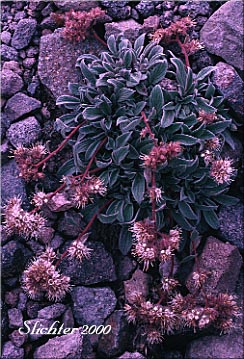 Photo at right of Phacelia hastata var. compacta from the Langille Crags
on Mt. Hood, Mt. Hood N.F.......July 3 1992. Note the basal cluster of silvery
leaves with numerous stems, in this case, prostrate agains the ground.
Photo at right of Phacelia hastata var. compacta from the Langille Crags
on Mt. Hood, Mt. Hood N.F.......July 3 1992. Note the basal cluster of silvery
leaves with numerous stems, in this case, prostrate agains the ground.
Silver-leaf phacelia is an attractive perennial wildflower with a taproot and one to several prostrate to more or less ascending stems from 10-30 cm hlong. Variety compacta tends to be more prostrate and often less than 15 cm high. The stems and leaves are covered with fine, short, silvery hairs. Any bristles that may be present are mostly ascending or appressed except in the inflorescence. The leaves are simple with prominent pinnate venation and the margins are usually entire, although some leaves may have a pair of small lateral lobes at the base of the blade. The basal leaves are numerous and tufted and narrowly to broadly elliptic in shape tapering to long petioles. The stem leaves are reduced in size and become sessile on the upper stems.
The inflorescence is usually short and compact, although it may occasionally be longer and thinner. The corolla 4-7 mm long and wide and is a dull white to lavender or dull purple in coloration. The filaments are conspicuously longer than the corolla lobes.
This phacelia can be identified fairly easily because of its subalpine to alpine habitat, large cluster of silvery-green leaves and many prostrate to slightly ascending stems.
Silver-leaf phacelia may be found in dry rocky to sandy locations at alpine or subalpine elevations.
Silver-leaf phacelia may be found from southern British Columbia east to Alberta and south to California, Colorado, and western Nebraska.
In the Columbia River Gorge, variety compacta may be found between the elevations of 2600'-3600' in the mid-gorge.